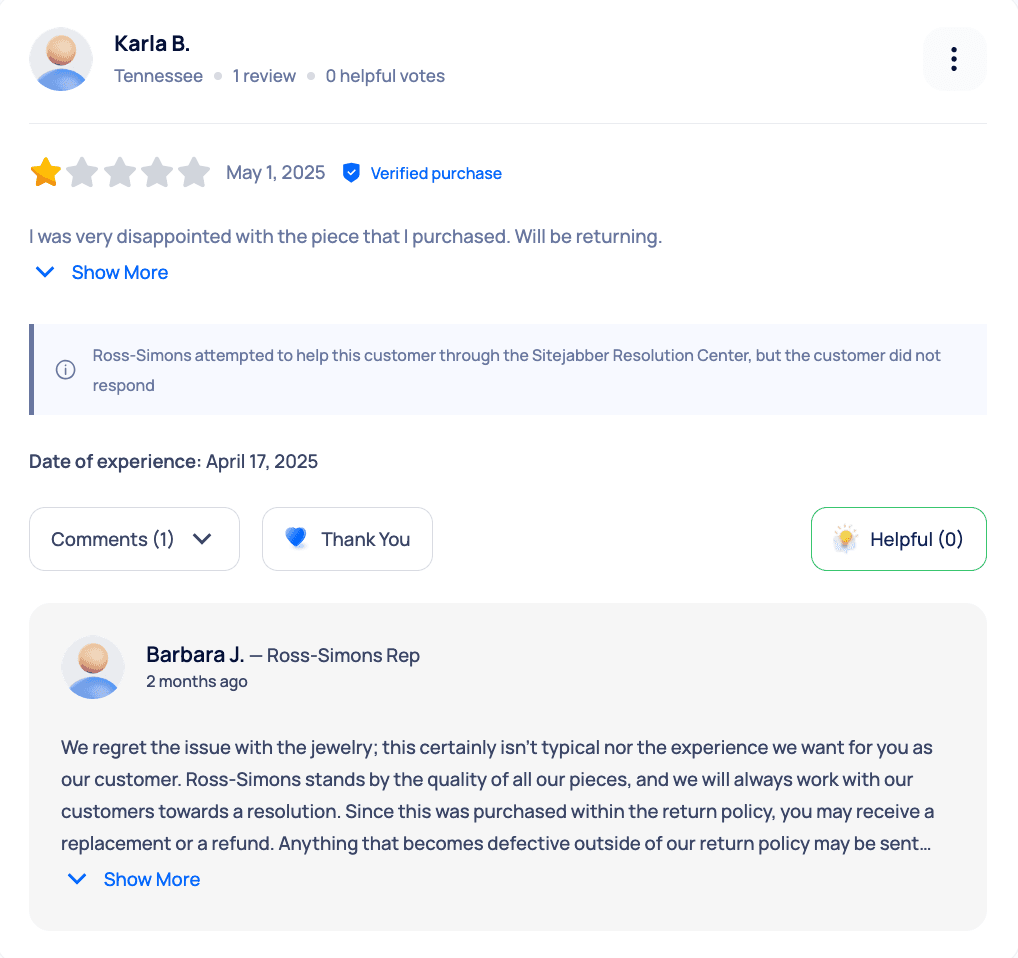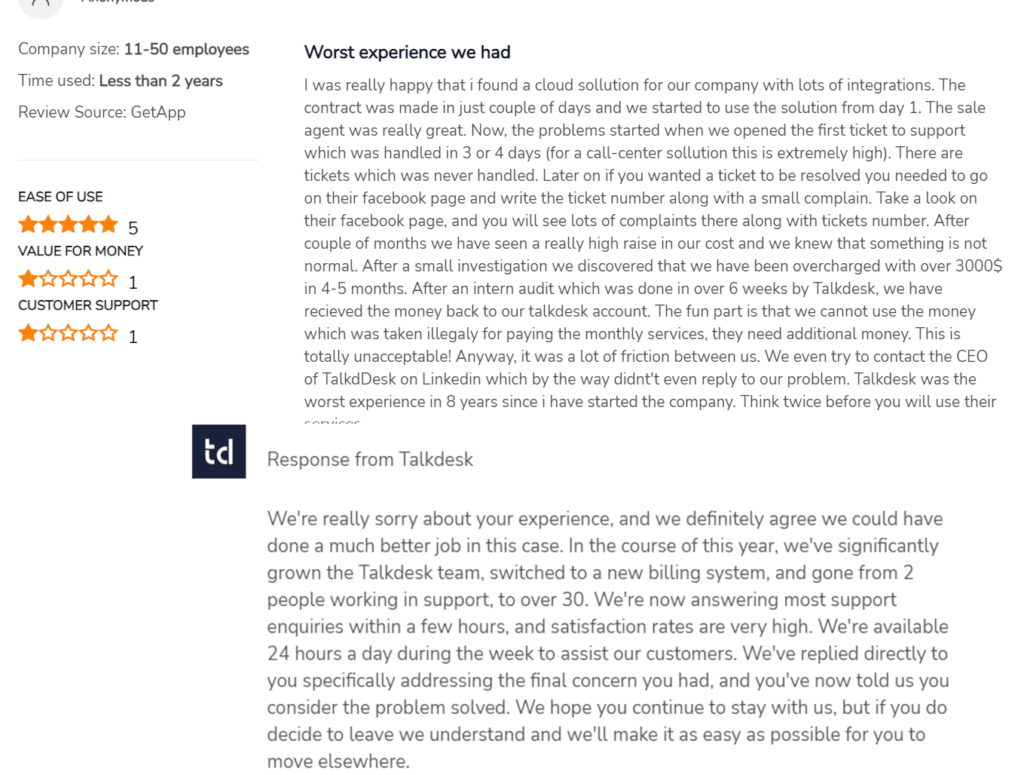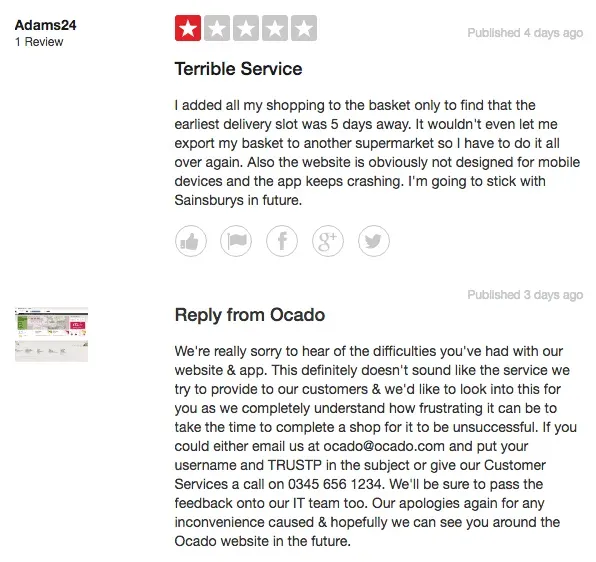While nobody enjoys getting negative reviews, they can provide insight into areas where your business needs to improve. Responding properly to reviews can also change customer perception and even turn people who weren't going to shop with you into advocates.
More than 99% of customers say they read reviews when they are shopping online or considering a purchase, and 96% of customers say they seek out negative reviews to find potential problems and see how companies respond.
Why Should You Respond to Negative Reviews?
Responding to negative reviews demonstrates you take any concerns seriously and are willing to resolve issues. They’ll get seen, so you want to use them as a chance to showcase your business in a more favorable light. Research from Google shows that businesses that respond are seen as 1.7X more trustworthy than businesses that ignore reviews. One study even showed that 70% of consumers will change their minds about a company when they respond.
Other studies show that when you respond to reviews that are favorable or unfavorable, you also encourage more reviews. When people know someone is reading and responding, they are much more likely to contribute.
When asked about the impact of a brand’s response to online reviews, here’s how people said it impacted their impression:
- 41% – Shows the company cares about its customers
- 35% – Demonstrates superior customer service
- 22% – Increases trustworthiness
- 14% – Shows that companies care about quality
So, replying to negative reviews can generate positive results, as long as you respond appropriately.
The Authenticity Factor
Customers don’t expect perfect reviews. In fact, having only 5-star ratings can make your reputation look suspect. Since some consumers actively look for poor reviews, how you respond to negative reviews is as important as getting positive reviews. It can be tempting to filter out negative reviews, but keeping them visible adds authenticity that helps consumers form more balanced opinions. Most consumers can recognize when bad reviews are unreasonable or over-the-top. Responding politely, even to absurd claims, can effectively neutralize their impact.
What Not to Do When Responding to Negative Reviews
Many businesses make big mistakes, some unknowingly, when handling negative feedback. Here are some things you want to avoid:
- Arguing with customers or being defensive: Even when you believe a reviewer is wrong, responding defensively damages your reputation more than the original review.
- Delaying responses: Aim to respond within 24-48 hours. Anything beyond 72 hours is considered delayed and signals that customer feedback isn't a priority.
- Responding but failing to acknowledge the issue: Simply saying "We're sorry for your experience" without addressing specific concerns appears insincere.
- Posting cookie-cutter responses to every review: Using identical templated responses for every review seems automated and uncaring.
- Using a response to advertise or market your services: Promoting products or services in your response to a complaint comes across as tone-deaf.
- Failing to offer solutions: Responding without explaining what you'll do to address concerns leaves customers feeling unheard.
- Only responding to negative reviews: This can actually encourage more critical reviews just to get your attention. Loyal and happy customers deserve the same attention. A simple response and expression of gratitude can make a positive impression.
How to Respond to Negative Reviews
Follow these best practices for responding to negative reviews:
- Provide timely responses
- Thank customers for their feedback
- Personalize the response
- Be authentic and avoid corporate-speak
- Acknowledge the issue
- Apologize and sympathize
- Explain any steps you plan to take to resolve an issue
- Follow up publicly to let them know when issues are resolved
If someone wants to argue or push back, ask them to take it offline so that you can talk to them privately. This avoids airing any additional negative comments and also makes it more personal. It’s easy to write a review when you’re anonymous (even if your name or online identity is associated with it). It’s more challenging to be as critical when you’re talking to a real person one-on-one.
You should also be aware of the cumulative impact of your reviews and comments. For example, telling every person that you take their complaints seriously and apologizing without taking action to resolve issues may be seen as disingenuous. It’s like when you call customer support and the message starts by saying “your call is important to us, please stay on the line”— and then you wait for 15 minutes. Obviously, the call isn’t that important or they would have the appropriate staff on hand to help.
Moderating Negative Reviews
Effective review management requires dedicated attention, so it's best to assign a specific person on the team to monitor and respond to reviews. This can also help with consistency. The person should check the review platforms daily and respond in 24-48 hours.
Having one person or team responsible for responding to reviews means they'll be able to better track patterns in feedback, and they can coordinate with relevant departments to resolve any issues. Once the problem is resolved, they should follow up with the customer to update them.
Responding to 1-Star Reviews
One-star reviews come from your most dissatisfied customers. Take a moment to process any emotional reaction before you write a response. Start by thanking the reviewer for highlighting the issue, and acknowledge their disappointment. The most effective responses take full responsibility without excuses, offer specific compensation when appropriate (such as a refund or discount), and clearly explain the changes you're implementing to prevent similar situations. Close by warmly inviting them to give your business another chance.
Good vs. Bad Review Responses

Poor Response Example
"We're sorry you had a bad experience. Our company strives to provide excellent service to all customers."
This example is ineffective because it's generic, doesn't acknowledge specific issues, offers no solution, and sounds automated.
Effective Response Example
"Hi Jennifer, thank you for taking the time to share your experience. I'm truly sorry that our checkout process caused you frustration and that you encountered errors when trying to complete your purchase. You're right that this shouldn't happen, and we take full responsibility. Our technical team has identified the problem with our payment gateway and implemented a fix yesterday. I've also arranged for a 15% discount on your next purchase (code: THANKS-JENNIFER) as a small way to make this up to you. If you have any other concerns, please contact me directly at sarah@company.com. We appreciate your feedback as it helps us improve. -Sarah, Customer Experience Manager"
This response works well because it's personalized, acknowledges the specific issue, explains the resolution, offers appropriate compensation, and provides direct contact.
Real-World Examples
Looking at actual review responses can help illustrate how to put the strategies and tips into action. These examples show how companies turn negative feedback into opportunities to showcase their values and solve problems for customers. Let's look at how businesses in various industries handle challenging reviews.
Responding to an E-Commerce Review
Ross-Simons acknowledges the problem without questioning whether it’s valid and offers a clear solution (replacement or refund).

Responding to a B2C SaaS Review
Grammarly opens with a personalized and friendly greeting, thanks the customer for sharing their feedback, apologizes, offers a solution, and asks for more information so they can improve the product.
Responding to a B2B SaaS Review
Talkdesk acknowledges the issue, shows tangible improvements, and mentions that they’ve resolved the issue privately.

Responding to a Food & Drink Review
Ocado recognizes the customer’s frustration, offers multiple solutions and contact methods to resolve the issue, and shows that they care by promising to pass feedback back to the IT team.

Negative Feedback Reveals Critical Areas for Improvement
When customers take the time to write negative reviews, it can also help you surface problems or see trends that you weren’t aware of. Many reviews provide specific insight into issues. By putting aside any emotional reactions and listening to customer feedback, you can find ways to improve.
Poor reviews can surface critical patterns that internal teams might miss.
For example, California-based brand Destira, which specializes in gymnastics leotards and apparel, uncovered two recurring issues through customer feedback: difficulties with their website’s search function and complaints about dye transfer from a popular red leotard.
Rather than dismissing the criticism, Destira used it as a catalyst for action. The team overhauled their website to improve product discoverability and worked closely with manufacturing to resolve the leotard’s colorfastness issues. This kind of responsive action not only improved the customer experience but also strengthened brand trust—showing that critical feedback can lead to meaningful change.
When you respond to customer frustrations or suggestions, it tells buyers you prioritize their needs and that you’re a brand worth spending dollars on. This can help your reputation beyond any one customer. Letting a reviewer know that you’ve added their preferred payment option or streamlined the checkout process eliminates any residual impact from the negative review. It can also attract new customers with similar concerns or complaints.
A Step-by-Step Process for Leveraging Poor Reviews
Let’s dive deeper. This five-step process will help you respond to negative reviews and leverage insights to improve your products and services.
In this example, we’ll use a Software as a Service (SaaS) platform. Its project management tool receives a poor review that mentions a confusing interface and difficulty in customization.
1. Acknowledge and Investigate
Reach out to the customer and find out specifics so you can validate the claim. Check if the customer initiated any support tickets or reached out to your support before posting a negative review.
2. Isolate the Root Cause
Assuming the complaint is valid, identify the underlying cause. Perhaps the user interface is poorly designed or cluttered, or key functionality is hidden in layered menus. The user onboard training might be insufficient, or your tool may lack customization options. Finding the root cause can help you resolve the issue, but it may also give you a significant competitive advantage to attract other customers.
3. Develop the Solution
The root cause helps you isolate the problem. In this example, the three things we mentioned have different fixes, whether it’s onboarding, lack of features, or poor user interface (UI). Once you get to the underlying issue, you can develop a solution. A poor UI may require a redesign and more UI testing. Improving customization may require developing new features and functionality. Enhancing onboarding may require overhauling customer training or better platform documentation.
4. Implement the Solution
Once you decide on a solution(s), implement and test it. You may want to reach out directly to any customers who left poor reviews or submitted support tickets and ask them to help you test your solutions. This can help turn unhappy customers into supporters.
5. Follow Up Publicly
Go back to any negative reviews, let them know you listened to their concerns, and list the steps you took to correct their problem or improve your product. This shows prospective customers that you’re dedicated to resolving issues and working hard to keep customers happy.
Turn Negatives into Positives
Negative reviews provide valuable insights that you might never get otherwise. If one person complains about a poor interface or problems during checkout, many others likely feel the same way.
The key to responding to negative reviews is being genuine — taking complaints seriously, helping customers solve problems, and using feedback to make improvements. While you can’t satisfy every customer, demonstrating your willingness to try builds trust and loyalty.
So, negative reviews are nothing to be afraid of. Instead, embrace them as part of your reputation management strategy and use them to improve products or services. You’ll turn around unhappy customers — and take huge steps in generating loyalty and enhancing trust in your company.







